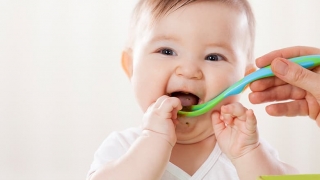When Can Babies Start Eating Baby Food? Tips for When and How to Introduce Solid Foods to Your Baby
Published on
Health Tip of the WeekPublished on
Health Tip of the Week If your baby is giving grown-up food a lingering stare, leaning in toward mom with her every bite, or opening their mouth and smacking their lips like it’s their turn for a taste, it’s probably time to start introducing solid foods to their diet, says Kristen S. Treegoob, MD, a pediatrician at CHOP Primary Care, Haverford.
If your baby is giving grown-up food a lingering stare, leaning in toward mom with her every bite, or opening their mouth and smacking their lips like it’s their turn for a taste, it’s probably time to start introducing solid foods to their diet, says Kristen S. Treegoob, MD, a pediatrician at CHOP Primary Care, Haverford.
Here, Dr. Treegoob offers advice for when and how to introduce solid foods to babies. She encourages parents to consider the whole process an adventure – it will take some trial and error (and some messy mealtimes), but you and your baby will get there!
While there is no strict rule and each child develops at a different pace, full-term babies typically hit the mealtime milestone at 4 to 6 months of age.
At 4 to 6 months old, children naturally become more aware and interested in their environment. As parents know all too well, this is also the stage when they’re orally fixated to the point that they will try to put everything in their mouth. This is a signal it may be a good time to start introducing solid foods.
Dr. Treegoob encourages parents to ask their pediatrician questions around their baby’s 4-month checkup. Your pediatrician can help you learn about how to introduce solid foods to your baby safely, as well as help you decide when to do it.
Before making the switch to solids, a child must have good head control, and have outgrown their tongue-thrust reflex, meaning they no longer push food away with their tongue.
When ready for solids, your child will open their mouth to accept food without spitting or pushing it out. But because it’s a new experience, the first few times may not go smoothly — even if your baby is ready. Keep trying if they spit out their food!
Babies who are ready to try solid foods will show interest in what family members are eating. They should also be capable of moving food from a spoon to their mouth and swallow without choking.
Making the leap from breast milk or formula to solids should be a shared and enjoyable experience, but your child should also understand that meals are not playtime.
Use this as a rule of thumb on what to feed your baby — and when — during three developmental stages:
For children who are slower to show interest in solid foods, have a strong gag reflex or immature chewing skills, eating solid foods may come a little later, and that’s OK. Talk to your child’s pediatrician if you have concerns.
Other tips to ease the transition as you teach your baby to eat solids:
While it’s recommended for parents of children at any age, knowledge of CPR can help boost parents’ peace of mind at mealtime.
The American Academy of Pediatrics (AAP) has a wide variety of recommended menu choices when introducing solid foods to your baby.
Though in the past parents were advised to start their baby with single-grain cereals, such as rice cereal, the AAP now says there’s no medical evidence that introducing solid foods in any particular order has any advantage for your baby, whether nutritionally or when it comes to their long-term palate.
What’s most important is that your baby receives the iron-rich foods their body needs. Whether it comes from iron-fortified cereals or a natural source like smoothly pureed red meat is up to you.
As long as your child’s safety and nutritional requirements remain priorities, don’t be afraid to try different foods to find what pleases your baby’s palate. Focus on introducing a variety of flavors and textures.
It is absolutely OK to offer soft, milk-based foods from 6- to 12-months old. The only dairy product to avoid is whole milk, which does not offer the range of nutrients and iron that breast milk and formula have. It will take time for your baby to get enough nutrients from table foods (closer to 12 months for most) and your child should continue receiving breast milk or formula during that time.
It is safe to give your child yogurt and cheese, as these can be great sources of protein. Typically, we recommend whole-fat yogurt, but non-dairy yogurts and cheeses are also OK.
Within a few months of starting solid foods, your baby’s daily diet should include a variety of foods, such as breast milk, formula, or both; meats; cereal; vegetables; fruits; eggs; and fish.
With all the concerns regarding food allergies, it’s important to note that there is no evidence that delaying the introduction of soft, baby-safe foods that are more commonly associated with allergies — such as eggs, dairy, soy, peanuts, or fish — prevents food allergy. In fact, there is evidence to the contrary: that early and continued introduction of these foods can reduce risk of allergies. These foods should be offered one at a time, and in a texture-appropriate way based on your child’s age and development.
For children with special needs, speak with your child’s pediatrician before making any dietary decisions. CHOP suggests reviewing these starter sample menus offered by the AAP.
Contributed by: Kristen S. Treegoob, MD